I’m a dedicated citizen entomologist with over ten years of experience. My desire to study insects is to help people identify and classify them. Gardens become a host of leaf-eaters during the spring season.
Caterpillars and larvae nibble holes in the leaves of your crops, and they come in different colors and sizes. The yellow fuzzy caterpillars are the cutest and most harmless among these destructive creatures.
These yellow caterpillars turn into moths or butterflies after some time. But they also leave plants dying. The information in this article provides everything you need to know about yellow caterpillars.
Take the time to read and learn about the most common types of yellow caterpillars with names and pictures. I have also shared some characteristics and a caterpillar identification chart for easy study.
You May Also Like:
What Do Yellow Caterpillars Look Like?
Caterpillars are among the growth stages of moths or butterflies. They have an elongated body and a hard head capsule. Some species have six legs and others more with a quarter an inch in length.
Caterpillars also come in different colors, patterns, and shapes with spots or stripes. These creatures belong to the Lepidoptera order, and they look like fat slugs or worms with exotic spiky bodies.
Most caterpillar species have a huge appetite, and they feed on vegetations before entering the pupal stage. They go through 4 to 5 growth stages and emerge as moths or butterflies. A juvenile caterpillar may look different from one another before becoming a pupa.
Caterpillars have different defense mechanisms to protect themselves against predators. A black caterpillar with yellow stripe appears unappetizing to other animals. A fuzzy yellow caterpillar with black spikes has venom that irritates.
Green caterpillars use camouflage mechanisms to hide from birds and other animals. Bright yellow caterpillar is among the five types and hails from North America. The fur density and yellow color shades will help classify these yellow caterpillars.
Yellow caterpillars’ identification can be challenging due to the numerous varieties. Today, I will help you identify yellow fuzzy caterpillars with pictures, descriptions, and scientific names.
10 Types of Yellow Caterpillars with Pictures
Identifying a yellow caterpillar is straightforward due to the yellow colors. Some fuzzy yellow caterpillars get the shade from their spiny hairs, and other yellow caterpillars have yellow and black stripes.
Most yellow caterpillars are furry due to their spikes or hairs. Some yellow fuzzy caterpillars have large horns at either end of their bodies. Besides that, they can sting due to their urticating furs. Let’s look at the different types of caterpillars with yellow bodies or yellow spikes:
American Dagger Moth Caterpillar (Acronicta americana)
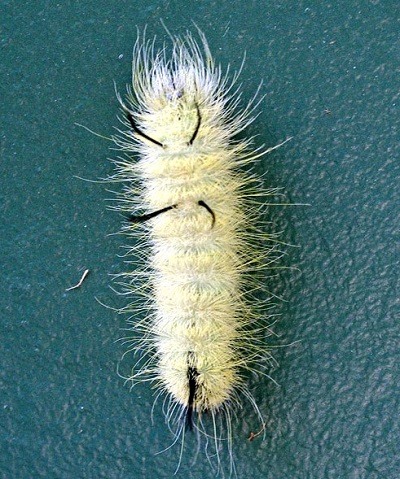
The caterpillar species has yellow urticating hairs with a shiny oval black head and long black pencil hair emerging from its body. The fuzzy yellow color turns pale yellow or white as the caterpillar matures.
A yellow caterpillar with black spikes can grow up to two inches long. It does not sting like a wasp, but the hairs contain venom that irritates and results in hives, welts, or dermatitis on the skin.
The American dagger moth caterpillars appear between July and October. These yellow fuzzy caterpillars love North America’s deciduous forests and woodlands since they feed on the leaves of elms, maples, oaks, birch, and hickory.
The yellow coloration, black spikes, and glossy round heads are crucial components for identifying the American dagger moth caterpillars. A mature caterpillar turns into a brown flying moth with white, tan, or dark brown markings on its wings.
Yellow Woolly Bear Caterpillar (Spilosoma virginica)
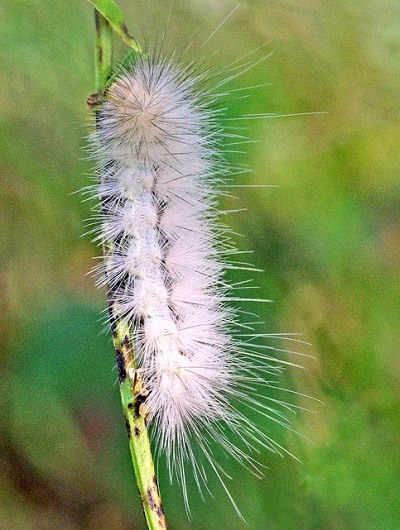
Yellow woolly bear caterpillars are the most common North American species. They are fluffy-looking caterpillars with long and thin spiky hairs. The fuzzy hair color can range from white, yellow, to reddish-brown.
The short bristles and extra-long hairs are the striking features to identify these caterpillars. But some yellow woollies have yellow bodies with long pencil hairs. These crawling furry can grow up to two inches long and love low-growing crops.
Yellow woollies are non-poisonous insects, but their hairs can irritate and cause skin dermatitis. These crawling creatures love munching carrots, sweet potatoes, and eggplant leaves. I recommend using protective gloves when removing these caterpillars from your garden.
A complete metamorphosis of the yellow woolly bear will result in the Virginia tiger moth. This beautiful white moth has wings that measure 1-2 inches long. Use the hairy appearance and long pencil hairs to identify the yellow woolly bear caterpillar.
Sycamore Tussock Moth Caterpillar (Halysidota harrisii)
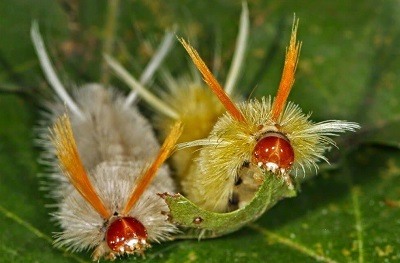
Sycamore tussock caterpillar is a member of tiger moths. The pale-yellow fuzzy caterpillar comes with orange and white spiky hairs.
These caterpillar species love eating leaves on sycamore trees. They can grow up to one inch long and prefer dwelling underneath the leaves.
The caterpillar has a pair of long orange pencil hairs on one end, and a pair of white pencil hairs on the other end. The fluffy-looking body is covered with light yellowish-white bristles.
The urticating hairs can irritate the skin and cause inflammation upon touching. Some people may experience an allergic reaction after handling the caterpillar. (Source: NCBI).
The sycamore tussock caterpillar emerges as a yellowish moth with bluish wings after the pupation stage. The adult sycamore moth has a plump short furry body and a wingspan of two inches.
Invite birds into your garden to help control the population of these destructive creatures. Use the small dots running on its body and pale-yellow bristles at its fee for identification.
Sycamore Moth (Acronicta Aceris)
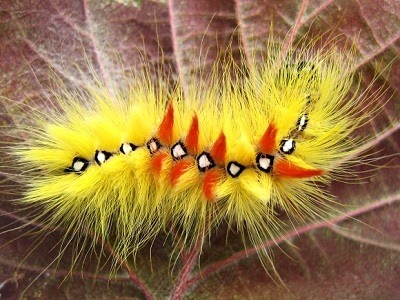
It is a hairy caterpillar species with orange and yellow bristles on its short body. These caterpillars hail from Europe and the Middle East.
The orange-yellow hairs are arranged in tufts along the length of its body. These bright colors make it easy to identify the caterpillar species.
The sycamore moth caterpillar has white dots running down the middle part of its back. These hungry grubs have blackheads with grey wings measuring 1.5 inches.
These yellow caterpillars prefer living on trees such as elms, maples, mulberries, and horse chestnuts. The long yellow or orange hairs make the caterpillar species conspicuous.
Yellow Spotted Tussock Moth Caterpillar (Lophocampa maculata)
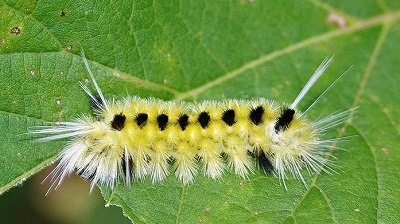
This is another beautiful yellow caterpillar species with black tufts of hairs. The caterpillar has short tufts of hairs with clumps of jet-black hairs running across its back.
The longer white pencil hairs sticking out on its feet and either end of its body make this species conspicuous. Other tussock species have black and yellow colorations.
The thick clumps of black hairs can irritate the skin upon handling. The thick yellow band around the middle with long spiky white hairs adds an extra striking appearance.
The yellow-spotted tussock moth caterpillars munch on leaves in the woodland forest. They prefer leaves from trees like oaks, maples, willow, and alders.
Cloudless Sulfur (Phoebis sennae)
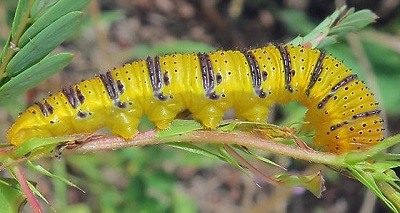
This is a smooth-bodied yellow caterpillar without hair at all. It becomes deep yellow with some greenish appearance while growing.
The caterpillar species have yellow or dark bands on some segments. It also has some small black dots that appear as tiny spikes.
The indentations of these small black dots running around the body give the species a stripe appearance. You can also notice the prolegs in the middle of the segments.
The green caterpillar species have a yellow line running the length on their bodies. The cloudless sulfur caterpillar can grow up to 1.8 inches.
These yellow caterpillar species prefer hiding and spending time sleeping underneath leaves. They only come out to eat at night on clover and legume plant leaves.
Six-Spot Burnet (Zygaena filipendulae)
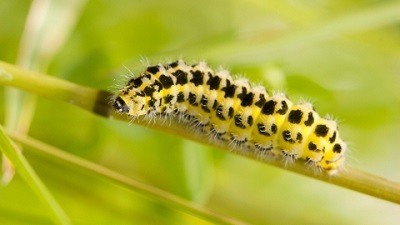
Another popular yellow caterpillar resembles a fat slug, and it goes through several growth stages before developing into a butterfly. It is usually pale green with black spots.
A mature hungry grub has a bright yellow body with black markings, and it also has some fine tiny hairs on its body. The contrasting colors make the caterpillar unappetizing to the predators.
The moth caterpillar has three pairs of red spots on the back wings of the adult. This small moth species have wingspans that measure 1.6 inches in length.
Tasar Silkworm Caterpillar (Antheraea mylitta)
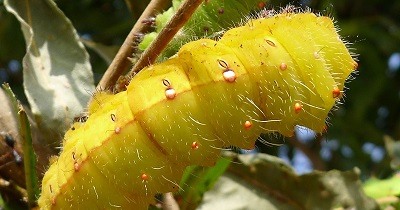
This yellow caterpillar species hail from India and the body color is prone to changes during its growth phase. It is a wild type of silkworm that produces high-quality and durable silk.
Tasar silkworm caterpillar has a flat and plumb body with visible segmented sections. The short fine white hairs with noticeable red spots around the segments make this species unique.
A silkworm moth has orange or brown wings with a white eye-like dot on each wing. It is known for producing strong and more durable silk than other domestic silkworms.
Pale Tussock (Calliteara pudibunda)
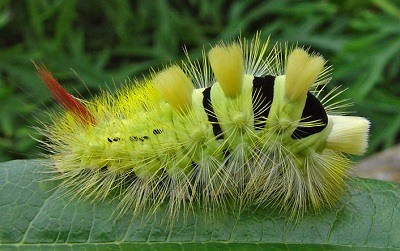
Another popular tussock caterpillar species with a yellow fuzzy appearance. It also comes with clumps of lemon-yellow and white hairs covering its body.
It has a tuft of yellow hairs on the back and white ones on the lower part above the feet. You can identify the caterpillar with the four tufts of bright yellow hairs on its back segments.
The hairy pale-yellow tussock caterpillars love munching the oak, birch, and willow leaves. The black bands separating the yellow segments and red fine hairs are ideal for identification.
Giant Peacock Moth Caterpillar (Saturnia pyri)
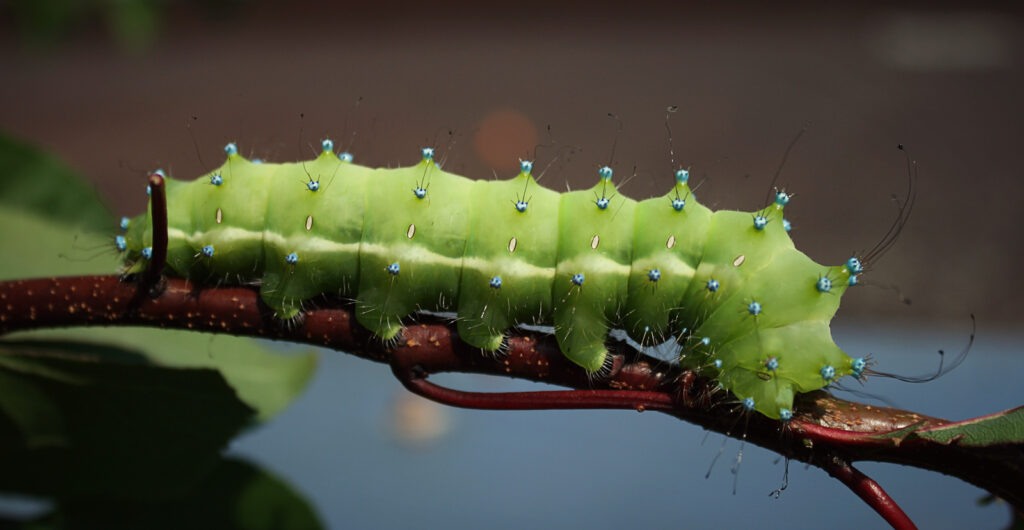
The giant peacock moth caterpillar is the most unusual crawling creature on this list. Both the caterpillar and adult moth are huge insects.
The yellow caterpillar species are vulnerable to color change during their growing phase. The larvae are dark after hatching from eggs then turn to dark yellow and finally golden green.
They have light blue dots around the segments and each segment has tiny stinging spikes that can cause skin irritation. They can grow up to five inches long before turning into the pupa phase.
Giant peacock caterpillars are the largest moth species in Europe. The wingspan ranges from 6 to 8 inches in length. The dark gray wings are ideal for camouflaging from their predators.
Frequently Asked Questions
Are Yellow Caterpillars Poisonous?
Yes. But the venom is less toxic and cannot kill anyone. It only causes skin irritation after touching. I recommend wearing protective gloves when handling the yellow caterpillars.
Can You Touch Yellow Caterpillars?
Yes. Most yellow caterpillars are safe to handle. But always use protective gloves to avoid skin irritation from the spiky hairs.
Are Yellow Caterpillars Poisonous to Dogs?
Yes. Some varieties of a yellow caterpillar with black stripes are extremely toxic to dogs and human beings. Tussock moth caterpillars have hairs that irritate the skin.
Are Caterpillars Good for Your Garden?
Yes. Caterpillars are beneficial to the gardens since they help in pollination. But you need to control their population to avoid leaf destruction.
Final Word
I hope the information in this article will help you come up with a comprehensive yellow caterpillar identification chart. Black and yellow fuzzy caterpillar is the most common species.
Feel free to share this information with your friends or family in various communities to provide more insights on yellow caterpillar with black stripes.
You May Also Like:
